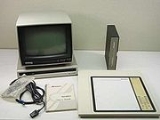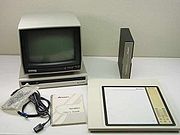
Pencept
Encyclopedia
Pencept, Inc. was one of a small number of pioneering companies in the 1980s developing and marketing technology known as Pen computing
, prior to the entry of larger companies such as Microsoft
and GO Corporation.
Pencept was noted primarily for the robustness (for the time) of the handwriting and gesture recognition algorithms, and for an emphasis on developing novel user interface
approaches for employing gesture recognition
and handwriting recognition
that would work with existing applications hardware and software. This was in contrast to the approach by GO Corporation to develop a complete new operating system
around a gesture-based UI, the PenPoint OS
, and to the approach by Microsoft with Windows for Pen Computing
and later the Tablet PC
to integrate Pen computing
features into the desktop metaphor of the Windows OS.
Pencept employed a proprietary technology for on-line character recognition, based on a functional attribute model of human reading. Thus, unlike many other recognition algorithms employed for handwriting recognition
, the recognition was generally user-independent and did not involve training to a user's particular writing style.
Early products included the PenPad 200 handwriting-only computer terminal
that was a direct replacement for the VT-100 and other standard ANSI 3.62 terminals, but with a digitizing tablet and electronic pen and no keyboard. With the advent of the IBM personal computer
, later products, such as the PenPad 320 focused particularly graphics and CAD/CAM applications for the DOS operating system, as well as for data entry and data editing applications.
The Pencept systems were featured in demonstrations at the 1983 and 1985 CHI conferences. A video showing parts of the 1985 demonstration at the CHI 85 conference is available from the Open-Video.org on-line collection.

Pen computing
Pen computing refers to a computer user-interface using a pen and tablet, rather than devices such as a keyboard, joysticks or a mouse....
, prior to the entry of larger companies such as Microsoft
Microsoft
Microsoft Corporation is an American public multinational corporation headquartered in Redmond, Washington, USA that develops, manufactures, licenses, and supports a wide range of products and services predominantly related to computing through its various product divisions...
and GO Corporation.
Pencept was noted primarily for the robustness (for the time) of the handwriting and gesture recognition algorithms, and for an emphasis on developing novel user interface
User interface
The user interface, in the industrial design field of human–machine interaction, is the space where interaction between humans and machines occurs. The goal of interaction between a human and a machine at the user interface is effective operation and control of the machine, and feedback from the...
approaches for employing gesture recognition
Gesture recognition
Gesture recognition is a topic in computer science and language technology with the goal of interpreting human gestures via mathematical algorithms. Gestures can originate from any bodily motion or state but commonly originate from the face or hand. Current focuses in the field include emotion...
and handwriting recognition
Handwriting recognition
Handwriting recognition is the ability of a computer to receive and interpret intelligible handwritten input from sources such as paper documents, photographs, touch-screens and other devices. The image of the written text may be sensed "off line" from a piece of paper by optical scanning or...
that would work with existing applications hardware and software. This was in contrast to the approach by GO Corporation to develop a complete new operating system
Operating system
An operating system is a set of programs that manage computer hardware resources and provide common services for application software. The operating system is the most important type of system software in a computer system...
around a gesture-based UI, the PenPoint OS
PenPoint OS
The PenPoint OS was a product of GO Corporation and was one of the earliest operating systems written specifically for graphical tablets and personal digital assistants...
, and to the approach by Microsoft with Windows for Pen Computing
Windows for Pen Computing
Windows for Pen Computing was a software suite for Windows 3.1x, that Microsoft designed to incorporate pen computing capabilities into the Windows operating environment...
and later the Tablet PC
Tablet computer
A tablet computer, or simply tablet, is a complete mobile computer, larger than a mobile phone or personal digital assistant, integrated into a flat touch screen and primarily operated by touching the screen...
to integrate Pen computing
Pen computing
Pen computing refers to a computer user-interface using a pen and tablet, rather than devices such as a keyboard, joysticks or a mouse....
features into the desktop metaphor of the Windows OS.
Pencept employed a proprietary technology for on-line character recognition, based on a functional attribute model of human reading. Thus, unlike many other recognition algorithms employed for handwriting recognition
Handwriting recognition
Handwriting recognition is the ability of a computer to receive and interpret intelligible handwritten input from sources such as paper documents, photographs, touch-screens and other devices. The image of the written text may be sensed "off line" from a piece of paper by optical scanning or...
, the recognition was generally user-independent and did not involve training to a user's particular writing style.
Early products included the PenPad 200 handwriting-only computer terminal
Computer terminal
A computer terminal is an electronic or electromechanical hardware device that is used for entering data into, and displaying data from, a computer or a computing system...
that was a direct replacement for the VT-100 and other standard ANSI 3.62 terminals, but with a digitizing tablet and electronic pen and no keyboard. With the advent of the IBM personal computer
Personal computer
A personal computer is any general-purpose computer whose size, capabilities, and original sales price make it useful for individuals, and which is intended to be operated directly by an end-user with no intervening computer operator...
, later products, such as the PenPad 320 focused particularly graphics and CAD/CAM applications for the DOS operating system, as well as for data entry and data editing applications.
The Pencept systems were featured in demonstrations at the 1983 and 1985 CHI conferences. A video showing parts of the 1985 demonstration at the CHI 85 conference is available from the Open-Video.org on-line collection.


